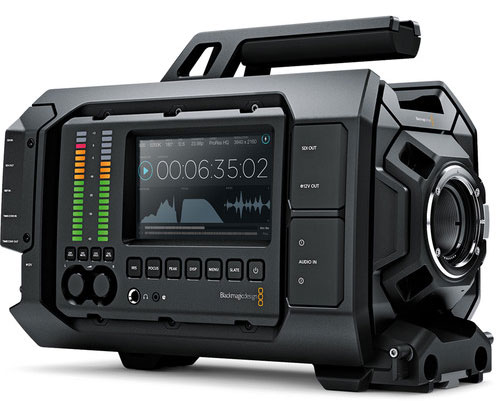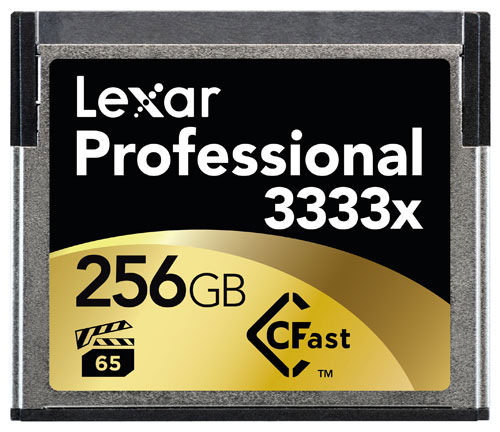
Recently, at NAB, Blackmagic Design stunned the production world with a revolutionary new 4K camera. Called the URSA, this new production camera from Blackmagic has features never seen before features on a camera with a price point under $7,000 US (Blackmagic URSA at B&H). First of all, the URSA has a 10-inch fold out monitor attached to the body of the camera on the DOP side via a heavy-duty hinge—this should last years of heavy production usage. Not only does the camera come with a large 10.1-inch monitor, it’s 1920×1200 resolution—a first for any production camera in terms of size and resolution. Thus, saving two-grand on a Marshall 9 inch or similar 3GSDI monitor. Next, the URSA comes with an interchangeable mount and sensor via the removal of four screws. This allows the user to change from EF to PL to B4 mount in a matter of minutes. Lastly, this leads us to our final item—the use of a new standard, the CFast media card—a blazing fast storage device based on a Compact Flash lineage.

The new CFast cards are based on their predecessor, the CF card. The CF card has been used in a variety of storage applications, most recently the majority of all DSLR cameras. CF, which stands for Compact Flash was the standard for all DSLR cameras up till 2005. According to the Compact Flash Wiki page, “A variant of CompactFlash known as CFast is based on the Serial ATA bus, rather than the Parallel ATA/IDE bus for which all previous versions of CompactFlash are designed. “
After 2005, SD cards gained more traction—especially with the Panasonic GH1 in March of 2009 and then latter with the GH2 and GH3. Prior to the introduction of the GH1, by 2005 SD cards had achieved 40% of the market with manufacturers such as Canon, Casio, Fujifilm, Kodak, Leica, Olympus, Pentax and Samsung using SD cards in many of their consumer product lines.
Flash forward to 2014. Due to the need for faster data transfer speeds with today’s data intensive cinema cameras, the need for faster cards has been part of the explosion in 2K and 4K cinema cameras that have hit the market in recent years. As of the article, there are two cameras, which currently use the new CFast cards: The Arri ALEXA and Blackmagic’s new URSA. Arri states on their website the their reasoning regarding their preference for CFast cards over the older SxS cards originally designed and manufactured by Sony, “Because of their high data rate, CFast 2.0 cards support higher frame rates than SxS PRO cards, enabling recording of ProRes 4444 up to 120 fps. The 120 GB CFast 2.0 cards have about twice the recording capacity of 64 GB SxS PRO cards.”
However, the New CFast cards come with a mixed blessing. On one hand the new cards are fast, fast enough for uncompressed video and the demands of high-speed 4K frame rates. On the other hand, the new CFast cards are not backwards compatible with Compact Flash cards of previous generations, and quite expensive—a 120mb SanDisk CFast card retails for around $1,200. Another item of note is that a 120mb CFast cad can only record 6 minutes of raw data in the new URSA camera and 20 minutes of ProRes, 10-bit 422. Lexar has a 256mb CFast card due out on the market soon, which should double the recording rates of SanDisk’s 120mb CFast card to 40 minutes and 12 minutes respectively. With the advent of a new camera, which gives you so many new features such as a 10.1-inch HD monitor, interchangeable, mounts and upgradeable sensors for future proofing your investment, there is always a give and take. The new CFast media may not be cheap, but as companies like Blackmagic Design and others continue to put affordable kit into the hands of indie filmmakers, the democratizations of cinema production continues to evolve in new and interesting ways.
About the Author: Thomas Cznarty is a lecturer at the State University of New York at New Paltz. Currently, he teaches in the Communication and Media department. He writes poetry, short fiction and screenplays. Thomas Cznarty is also a filmmaker and media producer with a strong background in film and television production.







[…] Blackmagic URSA (A Detailed Look – Blackmagic URSA and CFast Cards) , on the other hand retails for a little less. The Blackmagic URSAretails for between […]